Centauri Dreams
Imagining and Planning Interstellar Exploration
Antimatter: The Heat Problem

My family has had a closer call with ALS than I would ever have wished for, so the news of Stephen Hawking’s death stays with me as I write this morning. I want to finish up my thoughts on antimatter from the last few days, but I have to preface that by noting how stunning Hawking’s non-scientific accomplishment was. In my family’s case, the ALS diagnosis turned out to be mistaken, but there was no doubt about Hawking’s affliction. How on Earth did he live so long with an illness that should have taken him mere years after it was identified?
Hawking’s name will, of course, continue to resonate in these pages — he was simply too major a figure not to be a continuing part of our discussions. With that in mind, and in a ruminative mood anyway, let me turn back to the 1950s, as I did yesterday in our look at Eugen Sänger’s attempt to create the design for an antimatter rocket. Because even as Sänger labored over the idea, one he had been pursuing since the 1930s, Les Shepherd was looking at the antimatter prospect, and coming up with aspects of the problem not previously identified.
Getting a Starship Up to Speed
Shepherd isn’t as well known as he should be to the public, but within the aerospace community he is something of a legend. A specialist in nuclear fusion, his activities within the International Academy of Astronautics (he was a founder) and the International Astronautical Federation (he was its president) were legion, but this morning I turn to “Interstellar Flight,” a Shepherd paper from 1952. This was published just a year before Sänger explained his antimatter rocket ideas to the 4th International Astronautical Congress in Zurich, later published in Space-Flight Problems (1953).

Remember that neither of these scientists knew about the antiproton as anything other than a theoretical construct, which meant that a ‘photon rocket’ in the Sänger mode just wasn’t going to work. But Shepherd saw that even if it could be made to function, antimatter propulsion ran into other difficulties. Producing and storing antimatter were known problems even then, but it was Shepherd who saw that “The most serious factor restricting journeys to the stars, indeed, is not likely to be the limitation on velocity but rather limitation on acceleration.”
This stems from the fact that the matter/antimatter annihilation is so mind-bogglingly powerful. Let me quote Shepherd on this, as the problem is serious:
…a photon rocket accelerating at 1 g would require to dissipate power in the exhaust beam at the fantastic rate of 3 million Megawatts/tonne. If we suppose that the photons take the form of black-body radiation and that there is 1 sq metre of radiating surface available per tonne of vehicle mass then we can obtain the necessary surface temperature from the Stefan-Boltzmann law…
Shepherd worked this out as:
5.7 x 10-8 T4 = 3 x 1012 watts/metre2
with T expressed in degrees Kelvin. So the crux of the problem is that we are producing an emitting surface with a temperature in the range of 100,000 K. The problem with huge temperatures is that we have to find some way of dissipating them. We’d like to get our rocket operating at 1 g acceleration so we could tour the galaxy, using relativistic time dilation to send a crew to the galactic center, for example, within a human lifetime. But we have to dispose of waste heat from the extraordinarily hot emitting surfaces of our spacecraft, because with numbers like these, even the most efficient engine is still going to produce waste heat.

Image: What I liked about the ‘Venture Star’ from James Cameron’s film Avatar was that the design included radiators, clearly visible in this image. How often have we seen the heat problem addressed in any Hollywood offering? Nice work.
Now we can look at Robert Frisbee’s design — an antimatter ‘beamed-core’ starship forced by its nature to be thousands of kilometers long and, compared to its length, incredibly thin. Frisbee’s craft assumes, as I mentioned, a beamed-core design, with pions from the annihilation of protons and antiprotons being shaped into a stream of thrust by a magnetic nozzle; i.e., a superconducting magnet. The spacecraft has to be protected against the gamma rays produced in the annihilation process and it needs radiators to bleed off all the heat generated by the engine.
We also need system radiators for the refrigeration systems. Never forget that we’re storing antimatter within a fraction of a degree of absolute zero (-273 C), then levitating it using a magnetic field that takes advantage of the paramagnetism of frozen hydrogen. Thus:
…the width of the main radiator is fixed by the diameter of the superconductor magnet loop. This results in a very long main radiator (e.g., hundreds of km in length), but it does serve to minimize the radiation and dust shields by keeping the overall vehicle long and thin.
Frisbee wryly notes the need to consider the propellant feed in systems like this. After all, we’re trying to send antimatter pellets magnetically down a tube at least hundreds of kilometers long. The pellets are frozen at 1 K, but we’re doing this in an environment where our propellant feed is sitting next to a 1500 K radiator! Frisbee tries to get around this by converting the anti-hydrogen into antiprotons, feeding these down to the engine in the form of a particle beam.
Frisbee’s 40 light-year mission with a duration of 100 years is set up as a four-stage antimatter rocket massing millions of tons, with radiator length for the first stage climbing as high as 7500 kilometers, and computed radiator lengths for the later stages still in the hundreds of kilometers. Frisbee points out that the 123,000 TW of first-stage engine ‘jet’ power demands the dumping of 207,000 TW of 200 MeV gamma rays. Radiator technology will need an extreme upgrade.
And to drop just briefly back to antimatter production, check this out:
The full 4-stage vehicle requires a total antiproton propellant load of 39,300,000 MT. The annihilation (MC2) energy of this much antimatter (plus an equal amount of matter) corresponds to ~17.7 million years of current Human energy output. At current production efficiencies (10-9), the energy required to produce the antiprotons corresponds to ~17.7 quadrillion [1015] years of current Human energy output. For comparison, this is “only” 590 years of the total energy output of sun. Even at the maximum predicted energy efficiency of antiproton production (0.01%), we would need 177 billion years of current Human energy output for production. In terms of production rate, we only need about 4×1021 times the current annual antiproton production rate.
Impossible to build, I’m sure. But papers like these are immensely useful. They illustrate the consequences of taking known theory into the realm of engineering to see what is demanded. We need to know where the showstoppers are to continue exploring, hoping that at some point we find ways to mitigate them. Frisbee’s paper is available online, and repays a close reading. We could use the mind of a future Hawking to attack such intractable problems.
The Les Shepherd paper cited above is “Interstellar Flight,” JBIS, Vol. 11, 149-167, July 1952. The Frisbee paper is “How to Build an Antimatter Rocket for Interstellar Missions,” 39th AIAA/ASME/SAE/ASEE Joint Propulsion Conference and Exhibit, 20-23 July 2003 (full text).

Stephen Hawking (1942-2018)
The Tau Zero Foundation expresses it deepest sympathies to the family, friends and colleagues of Stephen Hawking. His death is a loss to the the world, to our scientific communities, and to all who value courage in the face of extreme odds.

Harnessing Antimatter for Propulsion
Antimatter’s staggering energy potential always catches the eye, as I mentioned in yesterday’s post. The problem is how to harness it. Eugen Sänger’s ‘photon rocket’ was an attempt to do just that, but the concept was flawed because when he was developing it early in the 1950s, the only form of antimatter known was the positron, the antimatter equivalent of the electron. The antiproton would not be confirmed until 1955. A Sänger photon rocket would rely on the annihilation of positrons and electrons, and therein lies a problem.
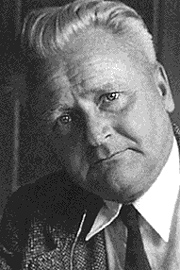
Sänger wanted to jack up his rocket’s exhaust velocity to the speed of light, creating a specific impulse of a mind-boggling 3 X 107 seconds. Specific impulse is a broad measure of engine efficiency, so that the higher the specific impulse, the more thrust for a given amount of propellant. Antimatter annihilation could create the exhaust velocity he needed by producing gamma rays, but positron/electron annihilation was essentially a gamma ray bomb, pumping out gamma rays in random directions.
Image: Austrian rocket scientist Eugen Sänger, whose early work on antimatter rockets identified the problems with positron/electron annihilation for propulsion.
What Sänger needed was thrust. His idea of an ‘electron gas’ to channel the gamma rays his photon rocket would produce never bore fruit; in fact, Adam Crowl has pointed out in these pages that the 0.511 MeV gamma rays generated in the antimatter annihilation would demand an electron gas involving densities seen only in white dwarf stars (see Re-thinking the Antimatter Rocket). No wonder Sänger was forced to abandon the idea.
The discovery of the antiproton opened up a different range of possibilities. When protons and antiprotons annihilate each other, they produce gamma rays and, usefully, particles called pi-mesons, or pions. I’m drawing on Greg Matloff’s The Starflight Handbook (Wiley, 1989) in citing the breakdown: Each proton/antiproton annihilation produces an average of 1.5 positively charged pions, 1.5 negatively charged pions and 2 neutral pions.
Note the charge. We can use this to deflect some of these pions, because while the neutral ones decay quickly, the charged pions take a bit longer before they decay into gamma rays and neutrinos. In this interval, Robert Forward saw, we can use a magnetic nozzle created through superconducting coils to shape a charged pion exhaust stream. The charged pions will decay, but by the time they do, they will be far behind the rocket. We thus have useful momentum from this fleeting interaction or, as Matloff points out, we could also use the pions to heat an inert propellant — hydrogen, water, methane — to produce a channeled thrust.

But while we now have a theoretical way to produce thrust with an antimatter reaction, we still have nowhere near the specific impulse Sänger hoped for, because our ‘beamed core’ antimatter rocket can’t harness all the neutral pions produced by the matter/antimatter annihilation. My friend Giovanni Vulpetti analyzed the problem in the 1980s, concluding that we can expect a pion rocket to achieve a specific impulse equivalent to 0.58c. He summed the matter up in a paper in the Journal of the British Interplanetary Society in 1999:
In the case of proton-antiproton, annihilation generates photons, massive leptons and mesons that decay by chain; some of their final products are neutrinos. In addition, a considerable fraction of the high-energy photons cannot be utilised as jet energy. Both carry off about one third of the initial hadronic mass. Thus, it is not possible to control such amount of energy.
Image: Italian physicist Giovanni Vulpetti, a major figure in antimatter studies through papers in Acta Astronautica, JBIS and elsewhere.
We’re also plagued by inefficiencies in the magnetic nozzle, a further limitation on exhaust velocity. But we do have, in the pion rocket, a way to produce thrust if we can get around antimatter’s other problems.
In the comments to yesterday’s post, several readers asked about creating anti-hydrogen (a positron orbiting an antiproton), a feat that has already been accomplished at CERN. In fact, Gerald Jackson and Steve Howe (Hbar Technologies) created an unusual storage solution for anti-hydrogen in their ‘antimatter sail’ concept for NIAC, which you can see described in their final NIAC report. In more recent work, Jackson has suggested the possibility of using anti-lithium rather than anti-hydrogen.
The idea is to store the frozen anti-hydrogen in a chip much like the integrated circuit chips we use every day in our electronic devices. A series of tunnels on the chip (think of the etching techniques we already use with electronics) lead to periodic wells where the anti-hydrogen pellets are stored, with voltage changes moving them from one well to another. The anti-hydrogen storage bottle draws on methods Robert Millikan and Harvey Fletcher used in the early 20th Century to measure the charge of the electron to produce a portable storage device.
The paramagnetism of frozen anti-hydrogen makes this possible, paramagnetism being the weak attraction of certain materials to an externally applied magnetic field. Innovative approaches like these are changing the way we look at antimatter storage. Let me quote Adam Crowl, from the Centauri Dreams essay I cited earlier:
The old concept of storing [antimatter] as plasma is presently seen as too power intensive and too low in density. Newer understanding of the stability of frozen hydrogen and its paramagnetic properties has led to the concept of magnetically levitating snowballs of anti-hydrogen at the phenomenally low 0.01 K. This should mean a near-zero vapour pressure and minimal loses to annihilation of the frozen antimatter.
But out of this comes work like that of JPL’s Robert Frisbee, who has produced an antimatter rocket design that is thousands of kilometers long, the result of the need to store antimatter as well as to maximize the surface area of the radiators needed to keep the craft functional. In Frisbee’s craft, antimatter is stored within a fraction of a degree of absolute zero (-273 C) and then levitated in a magnetic field. Imagine the refrigeration demands on the spacecraft in sustaining antimatter storage while also incorporating radiators to channel off waste heat.

Image: An antimatter rocket as examined by Robert Frisbee. This is Figure 6 from the paper cited below. Caption: Conceptual Systems for an Antimatter Propulsion System.
Radiators? I’m running out of space this morning, so we’ll return to antimatter tomorrow, when I want to acknowledge Les Shepherd’s early contributions to the antimatter rocket concept.
The paper by Giovanni Vulpetti I quoted above is “Problems and Perspectives in Interstellar Exploration,” JBIS Vol. 52, No. 9/10, available on Vulpetti’s website. For Frisbee’s work, see for example “How to Build an Antimatter Rocket for Interstellar Missions,” 39th AIAA/ASME/SAE/ASEE Joint Propulsion Conference and Exhibit, 20-23 July 2003 (full text).

Antimatter in Motion
Antimatter will never lose its allure when we’re talking about interstellar propulsion, even if the breakthroughs needed to harness it are legion. After all, a kilogram of antimatter, annihilating itself in contact with normal matter, yields roughly ten billion times the amount of energy released when a kilogram of TNT explodes. Per kilogram of fuel, we’re talking about 1,000 times more energy than nuclear fission, and 100 times the energy available through nuclear fusion.
Or we could put this into terms more suited for space. A single gram of antimatter, according to Frank Close’s book Antimatter (Oxford, 2010), could through its annihilation produce as much energy as the fuel from the tanks of two dozen Space Shuttles.
The catalog of energy comparisons could go on, each as marvelous as the last, but the reality is that antimatter is not only extremely difficult to produce in any quantity but even more challenging to store. Cram enough positrons or antiprotons into a magnetic bottle and the repulsive forces between them overcome the containing fields, creating a leak that in turn destroys the antimatter. How to store antimatter for propulsion remains a huge problem.
Here’s Close on the issue:
…`like charges repel’, so in order to contain the electric charge in a gram of pure antiprotons or of positrons, you would have to build a force field so powerful that were you to disrupt it, the explosive force as the charged particles flew apart would exceed anything that would have resulted from their annihilation.
As with so many issues regarding deep space, though, we tackle these things one step at a time. Thus recent news out of CERN draws my attention this morning. Bear in mind that between CERN and Fermilab we’re still talking about antimatter production levels that essentially have enough energy to light a single electric bulb for no more than a few minutes. But assuming we find ways to increase our production, perhaps through harvesting of naturally occurring antimatter, we’re learning some things about storage through a project called PUMA.
The acronym stands for ‘antiProton Unstable Matter Annihilation.’ The goal: To trap a record one billion antiprotons at CERN’s Extra Low ENergy Antiproton (ELENA) facility, a deceleration ring that works with CERN’s Antiproton Decelerator to slow antiprotons, reducing their energy by a factor of 50, from 5.3 MeV to just 0.1 MeV. ELENA should allow the number of antiprotons trapped to be increased by a factor of 10 to 100, a major increase in efficiency.
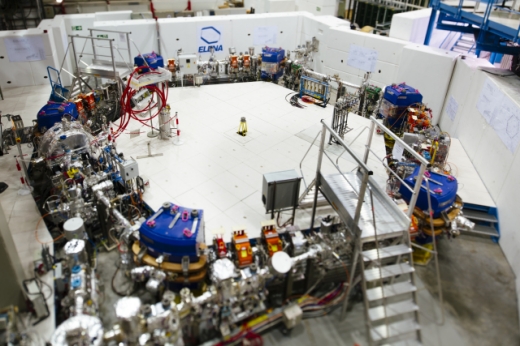
Image: The ELENA ring prior to the start of first beam in 2016. Credit: CERN.
The PUMA project aims to keep the antiprotons in storage for several weeks, allowing them to be loaded into a van and moved to a nearby ion-beam facility called ISOLDE (Isotope mass Separator On-Line), where they will be collided with radioactive ions as a way of examining exotic nuclear phenomena. The nature of the investigations is interesting — CERN has two experiments underway to study the effects of gravity on antimatter, for example — but it’s the issue of storage that draws my attention. How will CERN manage the feat?
This update from CERN lays out the essentials:
To trap the antiprotons for long enough for them to be transported and used at ISOLDE, PUMA plans to use a 70-cm-long “double-zone” trap inside a one-tonne superconducting solenoid magnet and keep it under an extremely high vacuum (10-17 mbar) and at cryogenic temperature (4 K). The so-called storage zone of the trap will confine the antiprotons, while the second zone will host collisions between the antiprotons and radioactive nuclei that are produced at ISOLDE but decay too rapidly to be transported and studied elsewhere.
Thus ELENA produces the antiprotons, while ISOLDE supplies the short-lived nuclei that CERN scientists intend to study, looking for new quantum phenomena that may emerge in the interactions between antiprotons and the nuclei. I’m taken with how Alexandre Obertelli (Darmstadt Technical University), who leads this work, describes it. “This project,” says the physicist, “might lead to the democratisation of the use of antimatter.” A striking concept, drawing on the fact that antimatter will be transported between two facilities.
Antiprotons traveling aboard a van to a separate site are welcome news. In today’s world, low-energy antiprotons are only being produced at CERN, but we’re improving our storage in ways that may make antimatter experimentation in other venues more practical. Bear in mind, too, that an experiment called BASE (Baryon Antibaryon Symmetry Experiment), also at CERN, has already proven that antiprotons can be kept in a storage reservoir for over a year.
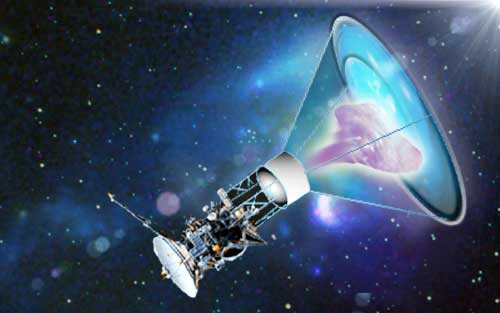
Image: A potential future use for trapped antimatter. Here, a cloud of anti-hydrogen drifts towards a uranium-infused sail. Credit: Hbar Technologies, LLC/Elizabeth Lagana.
We’re a long way from propulsion, here, but I always point to the work of Gerald Jackson and Steve Howe (Hbar Technologies), who attack the problem from the other end. With antimatter scarce, how can we find ways to use it as a spark plug rather than a fuel, an idea the duo have explored in work for NASA’s Institute for Advanced Concepts. Here, milligrams of antimatter are released from a spacecraft onto a uranium-enriched five-meter sail. For all its challenges, antimatter’s promise is such that innovative concepts like these will continue to evolve. Have a look at Antimatter and the Sail for one of a number of my discussions of this concept.

Lab Work on ‘Super-Earth’ Atmospheres
How we do laboratory work on exoplanet atmospheres is an interesting challenge. We’ve worked up models of the early Earth’s atmosphere and conducted well-known experiments on them. Still within our own system, we’ve looked at worlds like Mars and Titan and, with a good read on their atmospheric chemistry, can reproduce an atmosphere within the laboratory with a fair degree of accuracy.
In the realm of exoplanets, we’re in the early stages of atmosphere characterization. We’re getting good results from transmission spectroscopy, which analyzes the light from a star as it filters through a planetary atmosphere during a transit. But thus far, the method has mostly been applied to gas giants. Getting down to the realm of rocky worlds is the next step, one that will be aided by space-based assets like the James Webb Space Telescope. Can lab work also help?
Probing the Atmosphere of a ‘Super-Earth’
Worlds smaller than gas giants are plentiful. Indeed, ‘super-Earths’ are the most common planets we’ve found outside our own Solar System. Larger than the Earth but smaller than Neptune, they present us with a challenge because we have no nearby examples to help us project what we might find. That leaves us with computer modeling to simulate possible targets of observation and, in the lab, experimentation to see which mixture produces what result.
At Johns Hopkins University, Sarah Hörst has been conducting experimental work that varies possible exoplanet atmospheres, working with different levels of carbon dioxide, hydrogen and water vapor, along with helium, carbon monoxide, methane and nitrogen. Hörst and team adjust the percentages of these gases, which they mix in a chamber and heat. The gaseous mixture is passed through a plasma discharge that initiates chemical reactions within the chamber.
The research team used JHU’s Planetary Haze Research chamber (PHAZER) to conduct the experiments. A key issue is how to choose atmospheric compositions that would be likely to be found on super-Earths, as the paper on this work explains:
Atmospheres in chemical equilibrium under a variety of expected super-Earth and mini-Neptune conditions can contain abundant H2O, CO, CO2, N2, H2 and/or CH4, various combinations of which may have a distinct complement of photochemically produced hazes, such as ‘tholins’ and complex organics in the low-temperature, H2-rich cases, and sulphuric acid in the high-metallicity, CO2/H2O-rich cases. Warm atmospheres outgassed from a silicate composition can also be dominated by H2O and CO2. We therefore chose to focus on a representative sample of gas mixtures that are based on equilibrium compositions for 100×, 1,000× and 10,000× solar metallicity over a range of temperatures from 300–600?K at an atmospheric pressure of 1?mbar.

Image: This is Figure 2 in the paper. Caption: Due to the large variety of gases used for the experiments, this schematic provides a general idea of the setup. The details varied depending on the gases used, with attention paid to the solubility of gases in liquid water, condensation temperatures and gas purity. Credit: Sarah Hörst/JHU.
At issue is the question of haze, solid particles suspended in gas that can make it difficult to gauge the spectral fingerprints that identify individual gases. You might recall the clear upper atmosphere scientists found at the ‘hot Saturn’ WASP-39b (see Probing a ‘Hot Saturn’). Using transmission spectroscopy on this world, much larger than a super-Earth, Hannah Wakeford’s team at STscI found clear evidence of water vapor, and a surprising amount of it.
It was the fact that WASP-39b’s upper atmosphere is apparently free of clouds that allowed such detailed study of the atmospheric constituents. When we’re dealing with planets with haze, our ability to read these signs is more problematic. Learning more about the kinds of atmospheres likely to be hazy should help us refine our target list for future observatories.
Hörst’s laboratory work probes the production of haze, as the scientist explains:
“The energy breaks up the gas molecules that we start with. They react with each other and make new things and sometimes they’ll make a solid particle [creating haze] and sometimes they won’t,” Hörst said. “The fundamental question for this paper was: Which of these gas mixtures – which of these atmospheres – will we expect to be hazy?”
Two of the atmospheres in which water was dominant turned out to produce a large amount of haze, an indication that haze is not solely the result of interactions in methane chemistry. From the paper:
The two experiments with the highest production rates had the two highest CH4 concentrations, but the one with the third highest production rate (10,000× at 600?K) had no CH4 at all, demonstrating that there are multiple pathways for organic haze formation and that CH4 is not necessarily required. In the case of the experiment with no CH4, the gas mixture had CO, which provided a source of carbon in place of CH4. However, it is important to note that the production rates are not simply a function of carbon abundance, C/O, C/H or C/N ratios in the initial gas mixtures. This result also demonstrates the need for experimental investigations to develop a robust theory of haze formation in planetary atmospheres.
The researchers found a wide variation in particle color as a function of metallicity. The color of particles produced in the haze turns out to have an effect on the amount of heat it traps. Such findings may have implications for astrobiology, when we consider that primitive layers of haze could shield life in its early stages, preventing energetic photons from reaching the surface.
This work is in its early stages, as the paper makes clear:
Although models of atmospheric photochemistry and haze optical properties provide good first estimates, they are incomplete and biased due to the relatively small phase space spanned by the Solar System atmospheres on which they are based. Laboratory production of exoplanet hazes is a crucial next step in our ability to properly characterize these planetary atmospheres. These experimental simulations of atmospheric chemistry and haze formation relevant to super-Earth and mini-Neptune atmospheres show that atmospheric characterization efforts for cool (T?< ?800?K) super-Earth- and mini-Neptune-type exoplanets will encounter planets with a wide variety of haze production rates.
The paper also reminds us that hazes will have an effect on reflected light, which will have a bearing on future direct imaging of exoplanets. Lab work like this is part of building the toolsets we’ll need for probing rocky worlds around nearby stars in search of biosignatures. My assumption is that in the early going, we are going to see a lot of ambiguous results, with atmospheres with potential biosignatures being likewise capable of interpretation through abiotic means. Homing in on the most likely targets and understanding the chemistry at play will give us the best chance for success when looking at worlds so unlike any in our own system.
The paper is Hörst et al., “Haze production rates in super-Earth and mini-Neptune atmosphere experiments,” Nature Astronomy 5 March 2018 (abstract).

Juno’s View of Jupiter’s Turbulent Poles
The imagery we’re getting of Jupiter’s polar regions is extraordinary. Juno’s Jovian Infrared Auroral Mapper instrument (JIRAM) works at infrared wavelengths, showing us a vivid picture of a massive central cyclone at the north pole and eight additional cyclones around it. In the image below, we’re looking at colors representing radiant heat, with yellow being thinner clouds at about -13 degrees Celsius, and dark red representing the thickest clouds, at about -118 degrees Celsius. JIRAM can probe down to 70 kilometers below the cloud tops.
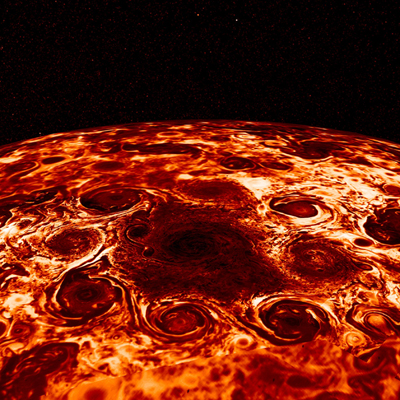
Image: This composite image, derived from data collected by the Jovian Infrared Auroral Mapper (JIRAM) instrument aboard NASA’s Juno mission to Jupiter, shows the central cyclone at the planet’s north pole and the eight cyclones that encircle it. Credit: NASA/JPL-Caltech/SwRI/ASI/INAF/JIRAM.
This is hardly the orange, white and saffron belted world we are familiar with from telescope views of the lower latitudes. The scale of these storms is, as you would expect with Jupiter, quite impressive. Alberto Adriani is a Juno co-investigator based at the Institute for Space Astrophysics and Planetology in Rome:
“Prior to Juno we did not know what the weather was like near Jupiter’s poles. Now, we have been able to observe the polar weather up-close every two months. Each one of the northern cyclones is almost as wide as the distance between Naples, Italy and New York City — and the southern ones are even larger than that. They have very violent winds, reaching, in some cases, speeds as great as 350 kph. Finally, and perhaps most remarkably, they are very close together and enduring. There is nothing else like it that we know of in the solar system.”
Adriani’s work on the Jovian polar regions is part of a four-paper set of Juno findings just published in Nature (citations below). We also learn that the planet’s south pole likewise contains a central cyclone, surrounded by five other cyclones with diameters ranging from 5,600 to 7,000 kilometers (the eight northern circumpolar cyclones have diameters between 4,000 and 4,600 kilometers). As Adriani tellingly asks, “…why do they not merge?”
Contrast this situation with Saturn, which houses a single cyclonic vortex at each pole, and it becomes clear that the differences between gas giants can be striking. We also see evidence at Jupiter that the winds dominating its zones and belts run deep, a phenomenon put on display by gravity measurements Juno has collected during its close flybys. “Juno’s measurement of Jupiter’s gravity field indicates a north-south asymmetry, similar to the asymmetry observed in its zones and belts,” said Luciano Iess, Juno co-investigator from Sapienza University of Rome, and lead author on a Nature paper on Jupiter’s gravity field.
That such asymmetries in gravitational measurements exist — and the visible eastward and westward jet streams are likewise shown to be asymmetric — tells us a great deal about how deep these powerful flows extend. This JPL news release explains that the deeper the jets flow, the more massive they are, creating a stronger signal in the gravity field. Juno’s gravity asymmetries thus become a marker for how far down these weather patterns extend.
The massive Jovian weather layer, east-west flows extending to a depth on the order of 3,000 kilometers, contains about one percent of the planet’s mass. Yohai Kaspi, lead author of another of the recent papers in Nature explaining the result, says that seeing the depth of these weather jets and their structure takes us from a two- to a three-dimensional view, adding: “The fact that Jupiter has such a massive region rotating in separate east-west bands is definitely a surprise.” We have much work ahead to determine what drives these jet streams; their gravity signature is entangled with that of Jupiter’s core.
On that score, the surprises seem likely to continue. For a final Juno result now being released suggests that the planet rotates below its massive weather layer as a rigid body.
“This is really an amazing result, and future measurements by Juno will help us understand how the transition works between the weather layer and the rigid body below,” said Tristan Guillot, a Juno co-investigator from the Université Côte d’Azur, Nice, France, and lead author of the paper on Jupiter’s deep interior. “Juno’s discovery has implications for other worlds in our solar system and beyond. Our results imply that the outer differentially-rotating region should be at least three times deeper in Saturn and shallower in massive giant planets and brown dwarf stars.”
Let’s close with a Juno image of Jupiter’s south pole as processed from JunoCam imager data by citizen scientist Gerald Eichstädt.
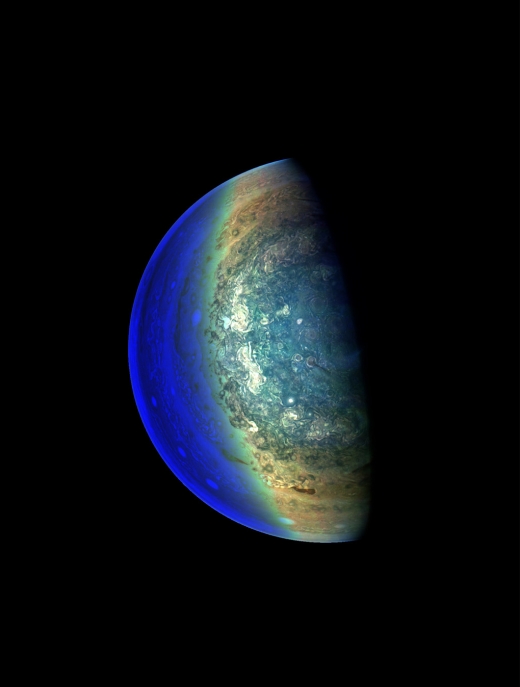
Image: This image captures the swirling cloud formations around the south pole of Jupiter, looking up toward the equatorial region. NASA’s Juno spacecraft took the color-enhanced image during its eleventh close flyby of the gas giant planet on Feb. 7 at 1011 EST (1411 UTC). At the time, the spacecraft was 120,533 kilometers from the tops of Jupiter’s clouds at 84.9 degrees south latitude. Credit: NASA/JPL-Caltech/SwRI/MSSS/Gerald Eichstadt.
All four papers are in Nature 555 (8 March 2018). They are: Adriani et al., “Clusters of cyclones encircling Jupiter’s poles,” 216-219 (abstract); Iess et al., “Measurement of Jupiter’s asymmetric gravity field,” 220-222 (abstract); Kaspi et al., “Jupiter’s atmospheric jet streams extend thousands of kilometres deep,” 223-226 (abstract); and Guillot et al., “A suppression of differential rotation in Jupiter’s deep interior,” 227-230 (abstract).


